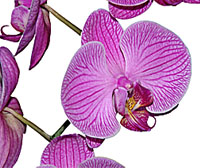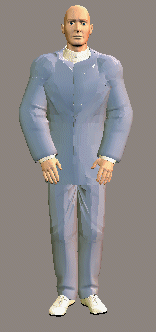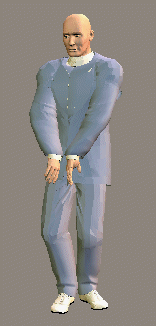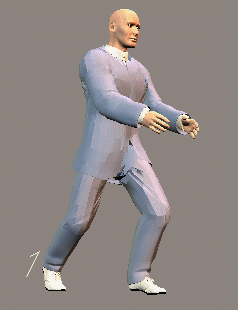
- Dao In Heart and Blood Wessels.
- 8 Forms Tutorial. Dynamic Taiji Qigong Meditation.
- Online tutorial covering Dao In Heart and blood vessels 8 forms techniques.
- Detailed illustrated descriptions, step by step.
In this tutorial you will find the set of Taiji Qigong techniques, called Qigong (Dao In) 8 forms. Dao In is an ancient name of the Qigong. As for the "8 forms", please keep in mind, that each form is rather complex, it usually involves more than one motion.
The Taiji Qigong "Dao In 8 forms" techniques are designed to improve general health, however the most effect they have on the heart conditions (including both heart and blood vessels). The exercises combine Qigong Meditation and self-massage, being - on one side - simple, they do a complex work with pressure points and energy channels.
If you do it right, Taiji Qigong is safe. If you make errors, or if you have some (very rare) health conditions, it may create unpleasant sensations. I am not going to discuss these "dangers" here, as there are sources in the Internet, dealing with the issue. I believe, that if you do it in a relaxed way, without pushing and if you do not do techniques that feel unpleasant - you will be fine. Nevertheless, read the disclaimer and find a local guru, if in doubts.
The eBook covers each aspect of the form in details.
Taiji Qigong Exercises: Sample
This is a selected chapter from the eBook (see below).
Form 2.
Initial position is the same as all the exercises of Dao In 8 forms.

Bend your knees and turn to the left (we always start to the left). In the same time move your wrists so they touch each other with the outer sides.

Move your weight on the back foot, in the same time bring your hands up, to the level of your shoulders. Lift the left heel, so that the left foot is touching the floor with the base of the toes.

Do an "empty step" forward - left (at 45 degrees), and in the same time move your hands apart, so that the angle between the hands is about 90 degrees. Note, that the wrists are now straight, and the back is always straight, unless I say "bend". Also note, that the hands are "round", forming an arch. It is achieved by bending the elbows slightly, still - it is very important - the elbows are kind of hanging down. We should have this "elbows down" feeling in all Tai Chi and Qigong techniques, we never force the elbow up. From the point of "energy" approach, the elbow up means shoulder up, which makes it tense, and cuts the energy flow. From the point of view of martial arts, the "elbow up" means an invitation for your opponent to attack the armpit area, which is very sensitive and should be protected.

The "empty step" mentioned above is one of the most important concepts in Tai Chi. Lets outline few vital points so that you do it correctly.
Attention: in the "blue" section the "standard" hands positions are used - it is not the part of the form 2.
After you moved ALL your weight to the right foot, you have your left foot "empty", touching the floor with the base of your toes. The right knee is bent. The line connecting your hips MUST be perpendicular to the direction your left foot is pointing to. This position is called Din Bu.
There are some very strict rules about steps in Tai Chi Martial Art. First of all, only an "empty" foot can move. It means that in order to lift the foot from the ground, you need to have no weight on this foot. You can not push from the ground, you can not move some weight and then drag the foot from one position to another. No weight.
Second, your front foot should touch the ground, but there should still be no weight on it. The heel should be up, and the contact with the floor should be on the base of the toes.
The right leg should be bent.
We are about to do an empty step. Put your left foot on the heel, forward. Keep the weight on the right foot - that is why the step is called "empty".
Note (it is one of the most common mistakes), that we cannot put our EMPTY heel forward, if our right foot is not bent. It is impossible - our legs have equal length. If one is perpendicular to the ground (as we stay on it, it is), the other can either be perpendicular too, or it should be longer than the first one, or it will not touch the floor. UNLESS we bend the right leg.
In Tai Chi, we walk in a smooth way, so that our center of gravity does not jump up and down. Once our leg is bent, we need to move in such way, that our head remains on the same level. When we do an empty step, we don't bend the right knee more than it is bent already.
Now move about 70% of your weight to the left foot. This position is called Gun Bu, as you already know, Gun means work. A working position. The left knee should be above the toes. It is different in different martial arts, so don't worry, if it is against the rules you learned in some other school. For example, in Kyokushinkai karate you would be told that the knee should be above the heel (shin vertical). In Tai Chi it is a little different.

It is important to have your hips at the line, perpendicular to the direction you are facing.
The moment you moved your weight forward far enough, you need to move your back heel, so that the back foot is now facing almost the same direction, the front foot does. Do it by rotating the heel around the balls of your foot.

The central line of your body, if you continue it down, should cross the floor between your feet, in the middle, not closer to your left foot.
The right knee should be almost straight, but still (as usual) slightly bent. When you moved all 70% of your weight, turn the right heel. If at the beginning it was 45 degrees to the right, now it should be almost parallel to the left foot (which is pointing same way your hips are pointing), but still slightly turned to the right.
The back should be straight and vertical. Also learn not to look down at your feet - they are there and you don't have to look to make sure.
Move your hands down through the sides, while moving 70 percent of your weight forward (we are completing an empty step by shifting into the Gun Bu position).

Then continue the motion, and bring your hands forward, palms up. At the end of this motion, bring your baby fingers up and focus your attention on them. Note that the elbows are hanging down (at least, they tend to) even when hands are to the sides. This is another important principle of Tai Chi Martial Art and martial arts in general.
The moment your hands are changing the direction from going down to going up, your back leg begins to move. It is as if your elbows are connected to your knee (take a look at the ground shadow at the picture).


It is important to remember, that we can only move an empty foot. So FIRST, move your weight, all of it, to the front (left) foot, and only then bring your right knee up.
At the end of this motion, the thigh should be horizontal, and relaxed. "Relaxed" means, that the shin is hanging down, and the ankle is relaxed, too.
Then move your right foot back to the position where it initially was, doing the prior footwork in reversed order - touch the ground behind you with the base of your toes. In the same time, bend your elbows, to bring your hands to your temples.
MAKE SURE YOUR SHOULDERS ARE DOWN. Bringing shoulders up is a critical error.

Then move your weight back a little, and put down the heel, finally, move all your weight on the right foot, but do not move the left heel.

Move 70 percent of your weight on your left foot, and in the same time bring your palms down. Imagine that you are staying in the water, and pushing down a ball. The fingers of you hands should be pointing forward and inside, at 45 degrees. As usual, the hands and legs are moving in synch, so the hands and legs arrive at the final position simultaneously.


In the final position, Bend your middle fingers and touch the Lao Gun points. Then straighten the fingers, as if you are shipping down some water.
Then bring your hands forward, in the same time turning them palms up. Simultaneously, bring up the back (right) knee, as if it was connected with the right elbow.

Turn right (now you are facing the same direction as at the beginning of this exercise). Your shoulders and hips should only move until they are facing the same way you were facing in the initial position, but your right elbow and your right knee should continue turning, so they point 45 degrees to the right.

Bring your right foot down, to the position with your heels together and toes to the 45 degrees to the sides. In the same time bring your palms to the temples.

Bring your hands down, to the initial position.
Do it again, this time to the right. The exercise (as well as all of the forms) should be done in a slow and smooth way, one motion seamlessly flowing into another.
